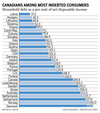Brace for it: after a long bull run, the Canadian housing market is correcting.
Economy
Housing’s hard stop spells trouble ahead for the economy


The list goes on. Fifth, in the low-interest period, more buyers opted for variable-rate mortgages, and they have faced instant resets with the sharp rise in interest rates this year. Changes in housing market conditions — especially selling prices — are like a nasty double-whammy for recent homebuyers. The list could be longer, but here’s one more: housing is a key leading indicator of economic activity. Where it goes, the rest of the economy usually follows. Recent homebuyers won’t be the only ones to get jolted; they are just the first to feel it.
Numbers released on Jan. 16 by the Canadian Real Estate Association (CREA) are sobering. Sales of existing dwellings fell 21 per cent in the second quarter of this year, then 14 per cent in the third and a further five per cent in the fourth to bring the year as a whole down by 38 per cent. True, this comes after an extraordinary surge in 2020-21, but sales levels are currently 16 per cent below the three-year pre-pandemic average. Through another lens, current sales have only been this far below the 10-year average twice since 2007, and the wedge is currently comparable to what we experienced in the 2009 recession.
New homebuilding activity seems to strongly disagree. In contrast to the United States market, housing starts in Canada are on a tear. Temporary factors might be the reason. Last year there was a highly unusual surge of non-permanent residents, a large portion of which were composed of Ukrainian immigrants fleeing war. This is expected to continue boosting building activity into 2023, as over 135,000 arrivals from Ukraine by land and air occurred in 2022, while at latest count, approved applications number over 470,000.

The conflict between the existing and new home markets, typically perfect substitutes, is a puzzle. However, the solution might simply come down to timing. Builders are under intense pressure to run hard while the market is red hot. But it takes time to buy land, zone it, clear it, service it, promote it, and then get on with the building. If you want a house now, it’s likely easier to buy an existing one — suggesting this latter market is a better indication of true, immediate market conditions.
If misery loves company, we’re almost flat out of luck. While interest rates are rising just about everywhere, housing markets aren’t reacting the same as Canada’s. Of the 14 countries covered in an Oxford Economics study late last year, Canada’s housing price correction is the largest, with only Sweden and New Zealand coming anywhere close. Their peak-to-trough forecast has Canada falling 30 per cent, New Zealand down 28 per cent, Sweden declining 20 per cent and Australia and the U.K. each shedding 11 per cent. All the rest are in the single digits, averaging a relatively mild four per cent correction. We are clearly the outlier at the bad end of the distribution.
If housing is still a reliable bellwether of the broader economy — and there’s no good reason to believe it isn’t — then alarming weakness at the leading edge of this prescient market spells trouble ahead. I earnestly hope that those who are confidently predicting a mild correction are right. I fear we are in for something much worse.
Peter Hall is chief executive of Econosphere Inc., and the former chief economist at Export Development Canada.

Economy
S&P/TSX composite gains almost 100 points, U.S. stock markets also higher

TORONTO – Strength in the base metal and technology sectors helped Canada’s main stock index gain almost 100 points on Friday, while U.S. stock markets also climbed higher.
The S&P/TSX composite index closed up 93.51 points at 23,568.65.
In New York, the Dow Jones industrial average was up 297.01 points at 41,393.78. The S&P 500 index was up 30.26 points at 5,626.02, while the Nasdaq composite was up 114.30 points at 17,683.98.
The Canadian dollar traded for 73.61 cents US compared with 73.58 cents US on Thursday.
The October crude oil contract was down 32 cents at US$68.65 per barrel and the October natural gas contract was down five cents at US$2.31 per mmBTU.
The December gold contract was up US$30.10 at US$2,610.70 an ounce and the December copper contract was up four cents US$4.24 a pound.
This report by The Canadian Press was first published Sept. 13, 2024.
Companies in this story: (TSX:GSPTSE, TSX:CADUSD)
The Canadian Press. All rights reserved.
Economy
Statistics Canada reports wholesale sales higher in July

OTTAWA – Statistics Canada says wholesale sales, excluding petroleum, petroleum products, and other hydrocarbons and excluding oilseed and grain, rose 0.4 per cent to $82.7 billion in July.
The increase came as sales in the miscellaneous subsector gained three per cent to reach $10.5 billion in July, helped by strength in the agriculture supplies industry group, which rose 9.2 per cent.
The food, beverage and tobacco subsector added 1.7 per cent to total $15 billion in July.
The personal and household goods subsector fell 2.5 per cent to $12.1 billion.
In volume terms, overall wholesale sales rose 0.5 per cent in July.
Statistics Canada started including oilseed and grain as well as the petroleum and petroleum products subsector as part of wholesale trade last year, but is excluding the data from monthly analysis until there is enough historical data.
This report by The Canadian Press was first published Sept. 13, 2024.
The Canadian Press. All rights reserved.
Economy
S&P/TSX composite up more than 150 points, U.S. stock markets mixed

TORONTO – Canada’s main stock index was up more than 150 points in late-morning trading, helped by strength in the base metal and energy sectors, while U.S. stock markets were mixed.
The S&P/TSX composite index was up 172.18 points at 23,383.35.
In New York, the Dow Jones industrial average was down 34.99 points at 40,826.72. The S&P 500 index was up 10.56 points at 5,564.69, while the Nasdaq composite was up 74.84 points at 17,470.37.
The Canadian dollar traded for 73.55 cents US compared with 73.59 cents US on Wednesday.
The October crude oil contract was up $2.00 at US$69.31 per barrel and the October natural gas contract was up five cents at US$2.32 per mmBTU.
The December gold contract was up US$40.00 at US$2,582.40 an ounce and the December copper contract was up six cents at US$4.20 a pound.
This report by The Canadian Press was first published Sept. 12, 2024.
Companies in this story: (TSX:GSPTSE, TSX:CADUSD)
The Canadian Press. All rights reserved.
-

 Sports17 hours ago
Sports17 hours agoArmstrong scores, surging Vancouver Whitecaps beat slumping San Jose Earthquakes 2-0
-

 News17 hours ago
News17 hours agoAs plant-based milk becomes more popular, brands look for new ways to compete
-

 News14 hours ago
News14 hours agoLabour Minister praises Air Canada, pilots union for avoiding disruptive strike
-

 News14 hours ago
News14 hours agoLooking for the next mystery bestseller? This crime bookstore can solve the case
-

 News17 hours ago
News17 hours agoLiberal candidate in Montreal byelection says campaign is about her — not Trudeau
-

 News17 hours ago
News17 hours agoB.C. victim’s family furious at no-fault insurance regime in motor-vehicle death case
-

 News17 hours ago
News17 hours agoAir Canada, pilots reach tentative deal, averting work stoppage
-

 News17 hours ago
News17 hours agoInflation expected to ease to 2.1%, lowest level since March 2021: economists
















